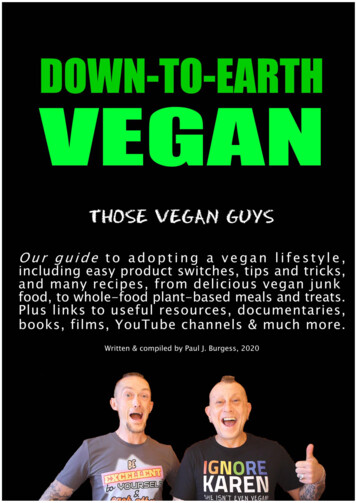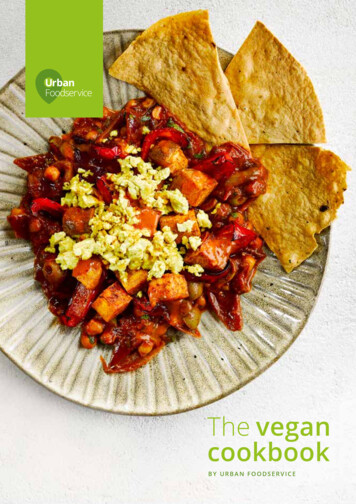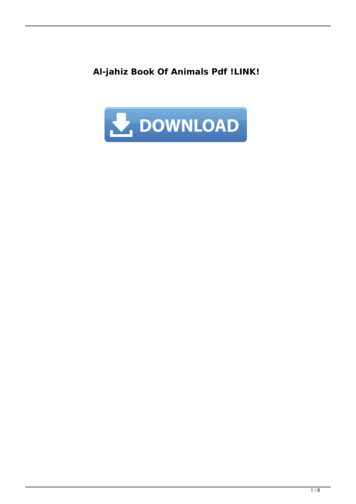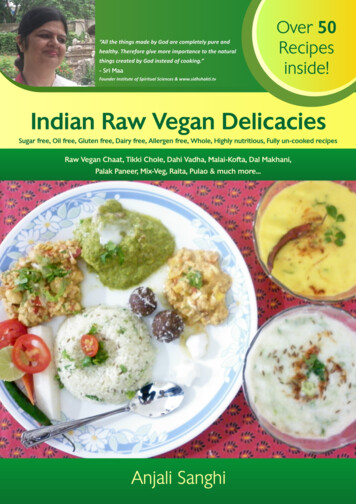
Transcription
Becoming vegan book pdf online free printable version
Becoming vegan book pdf online free printable versionBecause everyone is pressed for time, the need to look up the summary of this book or that one is sometimes a priority. Therefore, a wide variety of sites are available containing them. Follow these guidelines to learn where to find book summaries online.Websites and BlogsMany websites and blogs offer summaries of chapters in books for free totheir readers. Some present notes, reflections, and reviews that their readers can comment on, discuss, or reflect on. The purpose of these websites and blogs is to present an informal setting for people to enjoy books without feeling the pressure of making a purchase. Some of the bloggers and website owners also provide video and audio summaries,as well.It’s possible to find chapter summaries of books available through subscription services, as well as book apps. Some of these services provide audio, PDF, and infographics of the books. If that’s not enough, some of these book apps and subscription services also offer links to videos, reports and TED talks for the books, as well. Some of theseservices provide audio, PDF, and infographics of the books. If that’s not enough, some of these book apps and subscription services also provide links to videos, reports and TED talks for the books, as well.YouTube Channels Offering Book SummariesIf you would rather not read a summary of books, there are many YouTube channels offering booksummaries online. These “YouTubers” select a book, present information about it, provide insights, highlight reviews about it, and summarize its plot. Some of these channels follow a specific niche topic while others are about books in general.Research or Special Interest Book Summary WebsitesFor those who need a summary of a book that covers aresearch or special interest topic, there are dozens of book summary websites focusing specifically on this. While you may not find a short summary of Hamlet, you will see religious book summaries, book summaries for health-related topics, or topics for business-related books.Students Searching for Book SummariesStudents are constantly on thelookout for book summaries for research purposes, as well as for books they need to read for classes. For example, they may need a summary of Roberts rules or a simple summary of Macbeth to help them write a research paper, and a book summary website will help them achieve that goal. These book summary sites contain information about theauthor, release date, characters, plot, and then move on to the summaries, like a short summary of Othello, for example. MORE FROM QUESTIONSANSWERED.NET 2000 Brenda Davis and Vesanto Melina Cover design: Estelle Carol Interior design: Warren Jefferson and Cynthia Holzapfel Published in the United States by Book PublishingCompany PO Box 99 Summertown, TN 38483 1-888-260-8458 www.bookpubco.com All rights reserved. The use of any part of this publication reproduced, transmitted in any form or by any means, electronic, mechanical, recording, or otherwise, or stored in a retrieval system, without the prior consent of the publisher, is an infringement of thecopyright law. ISBN10 1-57067-103-6 ISBN13 978-57067-103-6 15 14 13 12 11 10 09 08 07 11 12 13 14 15 16 Davis, Brenda, 1959Becoming vegan / Brenda Davis, Vesanto Melina. p. cm. Includes index. ISBN 1-57067-103-6 eISBN 978-1-57067-955-1 1. Vegetarianism. I. Melina, Vesanto, 1942- II. Title. RM236 .D38 2000 613.2'62—dc21 00-058555The Book Publishing Co. is a member of Green Press Initiative. We have elected to print this title on paper with 30% postconsumer recycled content and processed chlorine free, which saved the following natural resources: 40 trees 14,410 gallons of water 1,850 lbs of solid waste 28 million BTUs 3,472 lbs of greenhouse gases For more informationvisit: www.greenpressinitiative.org. Savings calculations thanks to the Environmental Defense Paper Calculator at www.papercalculator.org CONTENTS TITLE PAGE COPYRIGHT PAGE ACKNOWLEDGEMENTS FROM THE AUTHORS 1: VEGAN ROOTS 2: PERSPECTIVES ON VEGAN HEALTH 3: PLANT PROTEIN 4: BIG FAT LIES 5: THE TWOFACES OF CARBOHYDRATES 6: PROSPECTING FOR MINERALS 7: VITAMINS FOR VEGAN VIGOR 8: PHYTOCHEMICALS 9: THE VEGAN FOOD GUIDE 10: BUILDING VEGAN DYNAMOS 11: GROWING VEGANS 12: THE PRIME OF LIFE 13: OVERWEIGHT 14: EATING DISORDERS 15: UNDERWEIGHT 16: THE VEGAN ATHLETE 17: VEGANDIPLOMACY APPENDIX: VEGAN RESOURCES GENERAL REFERENCES INDEX ACKNOWLEDGEMENTS To everyone who contributed time, attention, and energy to this project, we offer our heartfelt appreciation. Sincere gratitude to those who made this book possible: Cynthia Holzapfel, our editor, Bob Holzapfel, our publisher, Michael Cook,Warren and Barbara Jefferson, Gwynelle Dismukes, Barb Bloomfield, Kathleen Rosemary, and Anna Casini. It is a continuing pleasure and privilege to work with every one of you, both professionally and personally. Love and gratefulness to our families: Paul Davis (Brenda’s husband) and David Melina for support, advice, encouragement, and hours ofcomputer assistance. David, your example and experience as a 20-year vegan offered us incredible practical insight and tremendous inspiration. Leena Davis (Brenda’s daughter) for thoughtful review of the teen section and for taking over many household chores. Cory Davis (Brenda’s son), for fresh squeezed juices, shoulder rubs, and loving care thatmade each day a little brighter. Chris Crawford (Vesanto’s son and Kamloops artist) and Kavyo Crawford (Vesanto’s daughter, scuba diving instructor, and sailor); thanks for the joy of having both of you in our lives. Deepest appreciation to our cherished advisors and those sharing many hours of invaluable insight: The late Jay Dinshah and FreyaDinshah, Dr. Paul Appleby, John Borders, Jennie Sawyer, Dr. Michael Klaper, Dr. Mark Messina and Ginny Messina, M.S., R.D., Victoria Harrison, R.D., Dr. Paul Harrison, Parveen Girn, Sooze Waldock, artist Dave Brousseau (Vegan Food Guide Pyramid), and Estelle Carol, cover artist. Special thanks to those who contributed to specific chapters,providing thoughtful reviews and suggestions: Dr. Susan Barr, Dr. Winston Craig, Dr. Reed Mangels, Dennis Gordon, M.Ed., R.D., Corinne Eisler, R.D., Bob Bessed, Kevin Fichtner, Ketti Goudey, M.S., R.D., John Westerdahl, M.P.H., R.D., Dr. Neal Barnard, Lisa Dorfman, M.S., R.D., Samara Felensky-Hunt, R.D., Nancy Guppy, R.D., Mark Berman,Catherine Grainger, Julie Rosenfeld, Alex Herschaft, Lucy Goodrum, Liz da Silva, R.D., Dr. Bill Harris, Kristen Yarker, Bonnie Cheuk, Lauren Holm, Dr. Tim Key, Susan McFee, Valerie McIntyre, Amanda Benham, R.D., Barbara Txi Hannah, Shirley and Al Hunting, Wendy Laidlaw, Barb McCoy, Guy Frederickx, Kathleen Quinn, R.D., Jean Freemont,R.D., Monika Woolsley, M.S., R.D., Joseph Pace, Mike Koo, Maureen Butler, Davida Gypsy Brier, John Davis, Bruce Friedrick, Anne Marie Gentry, Dr. Stephen Walsh, Amanda Benham, and Dr. Sarwar Gilani. Warm acknowledgement to those who gave of their time and energy to support this project: Dr. Karl Seff, Fran Costigan, Joseph Forest, SarahEllis, M.S., R.D., Dr. Dean Ornish, Francis and Carol Sue Janes, Rose Kane, Graham Kerr, Karin Rowles, Ron Pickarski, Jennifer Raymond, M.S., Cherie Soria, Joanne Stepaniak, M.S.Ed., Yves Potvin, Howard Lyman, Suzanne Havala, M.S., R.D., Carol Coughlin, R.D., Sylvia Lambert, Peter and Irene Andor, Michelle Eng, and LaVonne Gallo. FROM THEAUTHORS Becoming vegan is an expression of one’s profound reverence for life. For some, it is a deliberate step towards the preservation of this planet. For others, it is a declaration of respect for all living things. For many, it reflects a commitment to personal health. Whatever the reason, a vegan lifestyle is a huge leap into a world that is verydifferent from the one in which most of us grew up. Every step you take towards a more compassionate world is one of celebration. We wish you much peace and joy in your journey. May Becoming Vegan serve as a powerful ally and traveling companion. Brenda Davis and Vesanto Melina Brenda Davis, R.D. Brenda Davis is a registered dietitian inprivate practice. She is coauthor of the best seller, Becoming Vegetarian, The New Becoming Vegetarian, and Defeating Diabetes. Brenda is a recognized leader in her field and an internationally acclaimed speaker. She is a past Chair of the Vegetarian Nutrition Dietetic Practice Group of the American Dietetic Association. She has worked as anacademic nutrition instructor, a public health nutritionist, a clinical dietitian, and a nutrition consultant. She specializes in essential fatty acid nutrition and lifecycle challenges. Brenda is currently working on a diabetes research project in the Marshall Islands. She is a committed vegan. Brenda lives with her husband and son in Kelowna BritishColumbia. Her website is www.brendadavisrd.com Vesanto Melina, M.S., R.D. Vesanto Melina is a registered dietitian and coauthor of The New Becoming Vegetarian, The Food Allergy Survival Guide, Becoming Vegetarian, Raising Vegetarian Children, and Healthy Eating for Life to Prevent and Treat Cancer. She is co-author of the most recentPosition Paper on Vegetarian Diets and the vegetarian section of the Manual of Clinical Dietetics, 6th edition, both joint projects of the American Dietetic Association and Dietitians of Canada. Vesanto is an internationally known speaker and consultant to individuals, government, and the food industry on vegetarian nutrition and foods. She has taughtnutrition on the faculty of the University of British Columbia and Bastyr University near Seattle. Vesanto has been vegetarian for 30 years and vegan for 15 years. She lives in Langley, near Vancouver, British Columbia. Her website is www.nutrispeak.com. DEDICATION To those who inspire us, with lives guided by conscience and compassion DonaldWatson Dr. Frey Ellis Jay and Freya Dinshah Bob and Cynthia Holzapfel and the vegetarian and vegan pioneers of The Farm Pioneering vegetarians and vegans of the American, British, and Australian Dietetic Associations, and Dietitians of Canada CHAPTER 1 Vegan Roots Pioneers of social reform are courageous individuals who are more concernedabout truth, justice, and humanity than about how they will be perceived by others. Without these strong and brilliant minds in our society, women would not vote, only the wealthy would be educated, and slavery would still be legal. For many years, vegetarian and vegan pioneers have been committed to the eradication of another great injustice: onethat is committed against the animals so many people call food. It began thousands of years ago with minds like Pythagoras, Buddha, Plato, and Plutarch. But it was not until the mid-1800s that a significant turning point came in Western culture. It was September 30, 1847, in England when a group of 140 people gathered together to express theirrespect for their own well-being (and that of animals) by asserting their unwillingness to eat flesh. This was the inaugural meeting of the Vegetarian Society, a group formed to publicly support meatless eating. The word “vegetarian,” which had been coined in 1842, was adopted by the Society; it is a term derived from the Latin “vegetus,” meaning“whole, sound, fresh, lively.” Vegetarian: One who abstains from the use of flesh, fish, and fowl as food, with or without the use of eggs and dairy products. The Vegetarian Society created a publication of its own titled The Vegetarian Messenger. Its message was simple—live and let live—and its members strove to lead by example. A primary force inthe Society, Joseph Brotherton (1783–1857), was the first Member of Parliament to speak against capital punishment. Like many other vegetarian leaders, he was interested in a range of humanitarian and compassionate reforms and worked to improve the harsh working conditions of children. Brotherton was born into a family of humble means, muchlike the segment of society he worked to help. As a young adult at the beginning of the 19th century, he had been influenced by the Reverend William Cowherd, a minister in Salford in the industrial north of England. Reverend Cowherd attracted a large congregation of members who took a vow not to eat meat. It was an era of extreme hardship forthe poor, and Cowherd’s offer of free vegetable soup gave parish members considerable practical support. The influence of Reverend Cowherd extended beyond what his early parishioners could have imagined. Another of his disciples, The Reverend William Metcalfe, set sail in 1817 for America with others from the Bible Christian Church. Two early,influential converts in the Philadelphia area were Sylvester Graham (fiery preacher, raw foods enthusiast, and originator of wholemeal Graham crackers) and Bronson Alcott (father of Louisa May). For a time Alcott even attempted to create a vegan community, an endeavor that must have been extremely challenging in that era! These men, along withothers they inspired, became the nucleus for the American Vegetarian Society that formed in 1850. The society took shape in an environment of widespread poverty and hardship, badly adulterated food, and alcoholism, but the times also inspired great leaders and idealists who eventually led movements to emancipate slaves and promote women’ssuffrage and universal education for children. Interest in vegetarianism fluctuated over the next century and a half. In the 1880s, as many as 34 vegetarian restaurants in London afforded, among other things, a safe and economical place for working women to eat. Arnold Hills (1857–1927), athlete, industrialist, and raw foods enthusiast, wrote insupport of “living foods” and against the widely held idea that meat was essential for muscle building. Members of the Vegetarian Cycling Club held world records; vegetarian magazines reported the benefits of meatless diets for endurance sports. George Bernard Shaw (1856–1950) was converted to vegetarianism while reading the passionate wordsof Shelley, whose diet had been near-vegan. Shaw’s writings offer both common sense and humor. “Don’t attribute every qualm you feel to a breakdown of your constitution through want of meat.” “This is the true joy in life; being used for a purpose recognized by yourself as a mighty one, and being a force of nature instead of a feverish, selfish littleclod.” A contemporary and friend, Mohandas (later Mahatma) Gandhi, was raised as a vegetarian. The philosophy of not eating animal flesh is in harmony with the Hindu concept of “Ahimsa” or harmlessness, a cornerstone of Gandhi’s Indian culture. His travels to study law in London came at a time of growing interest by Westerners in Easternphilosophy, ethics, and religion. Gandhi expressed the view that humanity’s natural food should be strictly nonanimal and the expectation that with further understanding of nutrition, knowledge of how to accomplish this would eventually come to light, enabling people to follow their consciences more consistently. By the 20th century, the preventionof malnutrition became a growing priority for North American and British governments. In England, for example, the diets of the poor were nearvegetarian; however, these diets were the result of economic hardship rather than ethical choice and were nutritionally inadequate, consisting primarily of white bread and tea! Some infants were fed a“milk” of flour and water; overall dietary, medical, and living conditions resulted in the death of one baby out of every four. By the beginning of World War I, a new meal-planning guide based on food groups was developed and promoted by the U.S. Department of Agriculture. Awareness of the benefits of newly identified vitamins and minerals hadeffects on both sides of the Atlantic. Scientific research illustrating the severe effects of protein deficiency made headlines. Analysis of different foods revealed that meat and dairy products were rich protein sources, and feeding trials showed that children could grow faster when fed these foods. In response, authorities supported increasedproduction and distribution of animal foods as a solution for many nutritional problems. Ahimsa is a Sanskrit term meaning nonharming or noninjuring and can be interpreted as “dynamic harmlessness.” The practice of Ahimsa includes avoiding specific foods and products, being considerate of the lives of humans and animals, and activelyparticipating in beneficial action. At the same time, some members of the vegetarian movement showed a reluctance to use animal products beyond flesh foods. Between 1909 and 1912, The Vegetarian Messenger showed support for a diet free of not only meat, but also eggs, milk, butter, and cheese, listing a number of ethical and health objectionsto the use of these animal products. In Britain, ethical considerations played a major role in the motivation of vegetarians, while in North America more emphasis was placed on health benefits, for example by The American Natural Hygiene Society. Though the interest in plant-based diets continued for a committed few, the majority of the populationwas won over to a dietary pattern in which animal products were easily accessible and highly prized. By the 1940s and 1950s, food policies which were ostensibly developed to ensure an adequate food supply included substantial subsidies for animal products. From about 1955, factory farming focused more on productivity and mechanization, and lesson providing livelihoods for rural families. People became increasingly distanced from the origins of their food. Scientific research was focused on obtaining enough of various nutrients for adequate growth and health. Relatively little attention was given to diseases of nutritional excess, environmental destruction, and the lives of farm animals. VEGANAWAKENINGS Within the vegetarian movement, some recognized the error in logic that would have us believe cows and chickens “give” us their milk and eggs. They noted that the females of these species are killed for food when productivity declines, the males earlier than that, and took the view that animals do not exist to be used by people. InNovember, 1944, a small group established the Vegan Society in London, and the word “vegan” was first coined by founding member Donald Watson. Members of the Society wished to eliminate exploitation of any kind in order to bring about a more reasonable and humane society and the emancipation of humans and animals. The Societyemphasized the moral, spiritual, social, health, and economic advantages of living by humane principles. The aims of The Vegan Society are: To advocate that man’s food should be derived from fruits, nuts, vegetables, grains, and other wholesome nonanimal products and that it should exclude flesh, fish, fowl, eggs, honey, and animals’ milk, butter,and cheese. To encourage the manufacture and use of alternatives to animal commodities. The Society was grateful to add to its membership Dr. Frey Ellis, who took a special interest in vegan health. He educated vegans about the health benefits of vegan diets, about the care necessary in bringing up children as vegans, and about vitamin B12,which had been discovered in 1949. Dr. Ellis was a medical doctor at Kingston hospital and a consultant hematologist for the region. He conducted much of the early research on vegan health as time went by, including graduate students who worked under his direction. Dr. Ellis became a council member and vice president of the Vegan Society in1961 and was its president from 1964 until he died in 1978. This gentle man worked to show the scientific world that a vegan diet could be nutritionally adequate. At the same time, he provided some needed guidance to vegans. Veganism may be defined as a way of living which seeks to exclude, as far as possible and practical, all forms of exploitationof, and cruelty to, animals for food, clothing, or any other purpose. In dietary terms, it refers to the practice of dispensing with all animal produce, including meat, fish, poultry, eggs, animal milks, honey, and their derivatives. International Vegetarian Union In 1960 the American Vegan Society was founded in the United States by Jay Dinshah, a vegansince 1957. He was soon joined by his new English bride, Freya, whose vegetarian family had been neighbors of Dr. Ellis and his family in England. Both Dinshahs had been lifelong vegetarians before becoming vegan. Then, as now, the Society encouraged active participation in Ahimsa as a part of vegan living and views this way of life as an urgent,worldwide necessity. It established the following “six pillars of the compassionate way” using “Ahimsa” as an acronym: Abstinence from animal products Harmlessness with reverence for life Integrity of thought, word, and deed Mastery over oneself Service to humanity, nature, and compassion Advancement of understanding and truth A vegan diet isderived from fruit, vegetables, grains, legumes, nuts, seeds, and other wholesome nonanimal products. In 1975, a World Vegetarian Congress was held at the University of Maine in Orono by a new umbrella organization called the North American Vegetarian Society (NAVS). Jay Dinshah was founding president. This event attracted members totaling1,500 participants and 90 speakers from 30 countries. Serena Coles’ lecture to the Congress, entitled “Blueprint for A Humane World,” propelled many toward veganism. Environmental, ethical, and health reasons for not using animal foods were strongly presented. Although eggs and dairy were optionally available at the 13-day event, dishesprepared and catered by Freya Dinshah were all vegan and led to a set of recipe cards, “Vegetarian Cooking for 100.” These recipes later came to be used by thousands of universities, hospitals, nursing homes, and prisons. To quote participant Ann Cottrell Free: “Lives were changed for a variety of philosophical and health reasons. But perhaps themain reason for the success of Orono was the realization that we were not alone and that we were in the vanguard of a healthier future no longer based on the enslavement of other beings.” ANIMAL FOODS UNCOVERING THE COSTS In waves throughout the ’70s and ’80s, new segments of the population became aware of the devastatingconsequences of our animal-centered diets. Frances Moore Lappé’s book, Diet for a Small Planet (1971), introduced many to the effects on the environment and human hunger, and interest in vegetarianism began to grow in middle class America. Laurel’s Kitchen (1976) examined the human health issues and nutritional considerations involved inplanning a balanced vegetarian diet. This was followed by numerous successful cookbooks, such as Moosewood Cookbook (1977), which provided immensely appealing recipes using milk products and eggs along with plant foods. Soon people discovered that quiche, grilled cheese sandwiches, and three-cheese lasagne could contribute to weight gainand a rise in cholesterol as easily as a meatcentered diet. Because dairy products lack iron and interfere with absorption of this mineral, iron-deficiency anemia became a problem for some vegetarians who relied on dairy, rather than legumes, as primary protein sources. Nutrition textbooks of the day often included information about vegetarian dietsin the “fad diet” section of the book. Readers were cautioned that vegetarianism was risky and even downright dangerous for children. How is “vegan” pronounced? In North America and the U.K, the correct pronunciation is “veegun.” You may hear other pronunciations as well, such as “vee-gn,” “vay-gn,” and “vee-jan.” The Farm: Vegan CommunityThe Farm, a community of 1,500 people located in southern Tennessee, played a vital role in the early ’70s in proving the viability of a vegan diet by becoming the largest group of intentional vegans known up to that point. Importantly, it was certainly the first group to include large numbers of children, including babies, and pregnant and lactatingwomen. The Farm collaborated with the Centers for Disease Control in publishing the results of a study on the growth rates of its children in a 1989 issue of Pediatrics magazine (vol. 84, no. 3), with the conclusion that vegan children eating a varied diet could grow at rates comparable to nonvegan children. (See O’Connell et al, Table 2.1). Seventhday Adventist Contributions Members of the Seventh-day Adventist church have made outstanding contributions in the area of vegetarian nutrition. A central part of this religious tradition, founded in the mid-1900s, is taking care of the body as a temple of the Holy Spirit. Based on the understanding that the original diet of humans was plant-based,approximately 30% of Seventh-day Adventists are vegetarian, 50% use meat less than once a month, and 1–2% are vegan. Adequate rest, sunshine, water, and an avoidance of smoking, caffeine, and alcohol are part of the lifestyle, with the result that these are considered to be among the healthiest people in North America. The classic work onadequacy of plant protein was done in a joint venture between the Seventhday Adventist Loma Linda University in California and Harvard University. Dr. Mervyn Hardinge and his associates contributed much to our understanding of vegetarian nutrition. He demonstrated that vegetarian diets were adequate for adults, pregnant women, andadolescents, and that vegetarian diets provided all the necessary amino acids. For many years, it was not easy to win acceptance for the excellent research that was done on the overall sufficiency of plant-based diets. However, with perseverance and time, the immense value of the extensive investigation done in the field of vegetarian nutrition hasbeen recognized. Among the most impressive research to date on vegetarian and vegan populations is that from the Adventist Health Studies. These studies have demonstrated important health advantages of vegetarian and vegan diets. (See Fast Facts from the Adventist Mortality and Health Studies, Fast Facts from Adventist Mortality and HealthStudies, and Fast Facts from the Seventh-day Adventist Prospective Diabetes Study.). While Adventists have traditionally been lacto-ovo vegetarians, dietary philosophy has stated, “ the time will come when we may have to discard some of the articles of diet we now use, such as milk and cream and eggs.” Fast Facts “Food” Animals General Foodanimals slaughtered, North America 1999: more than 10 billion Animals killed for food worldwide, 1998: 43.2 billion Proportion of all antibiotics that are used in animal agriculture: 40% Proportion of these antibiotics that are used to promote rapid growth: 80% Veal Calves, Dairy Cows, and Cattle Calves taken from their mothers within 24 hours ofbirth: 90% Calves that never suckle from their mothers’ udders: 50% Natural life span of cow: 20 years Fate of a dairy cow at 5 to 6 years of age: ground beef Fate of most male calves at 4 months of age: veal Livestock farms that are confined feedlot operations (U.S.): over 70% Cattle feed operations that account for over 40% of cattle sold (U.S.): 2%.Laying Hens Eggs per year per laying hen before factory farming: 70 Eggs per year per laying hen today: 250 Percent of laying hens that suffer broken bones in their cage: 30%. Male chicks (from laying hens) killed per year by suffocation, gas, or grinding in the U.S.: 200 million Male chicks used per day for fertilizer, chicken food, and pet food inCanada: 40,000 Chickens (U.S.) Mass of breast tissue of 8-week-old chicken today compared with 25 years ago: 7 times Broiler chickens that have trouble walking: 90% Chickens still alive at the scald tank: 20% Number of chicken farms, 1969 to 1992: 35% decrease Number of chickens slaughtered, 1969 to 1992: 200% increase Pigs (U.S.) Producerswith over 50,000 hogs in 1988: 7% Producers with over 50,000 hogs in 1997: 37% Number of hog farms now compared to 50 years ago: 4% Pigs with pneumonia at time of slaughter: about 70% Pigs who are lame at time of slaughter: 50% Pounds of corn and soy to produce one pound of pork: 7 pounds Manure Rating of agriculture, crops, andlivestock as a source of water pollution in the U.S.: No. 1 Approximate tons of manure from North American food animals per year: 1.5 billion Approximate tons of solid sewage waste from North American humans per year: 0.73 billion Feces and urine from livestock for each 0.3 kg serving of meat: 16 kg Related Human Issues Cumulative traumadisorders among poultry workers, compared to national average: 16 times Children dying of starvation or malnutrition per day, worldwide: more than 33,000 Portion of U.S. grain crop fed to animals destined for slaughter: 70% Estimated U.S. health care costs per year related to excessive meat consumption: 60- 120 billion The Seventh-dayAdventists operate prestigious universities around the world, including Loma Linda University, and numerous hospitals and holistic retreats. The Seventh-day Adventist Dietetic Association, a nonprofit organization of vegetarian dietitians, has been an invaluable source of nutrition information for health professionals for 40 years. They offer numerousinexpensive health education forums, conferences, and cooking classes, run natural food stores, create vegetarian diet manuals, cookbooks, audiovisual materials, and books for health professionals and the public. The Adventist community also introduced soymilk (having learned of it in China) and made available delicious, easy-to-use vegetarian meatsubstitutes. The Well-Being of Animals In 1987, Diet for A New America by vegan activist John Robbins drew attention not only to human health, hunger, and environmental issues relative to animalcentered diets, but also to the plight of farm animals in current food production systems, including laying hens and dairy cows. It was a shock for mostpeople to learn of the routine debeaking of chickens (followed by weeks of pain for the birds) and to discover that mi
Becoming vegan book pdf online free printable version Because everyone is pressed for time, the need to look up the summary of this book or that one is sometimes a priority. Therefore, a wide variety of sites are available containing them. Follow these guidelines to learn where to find book summaries online.Websites and BlogsMany websites and .










